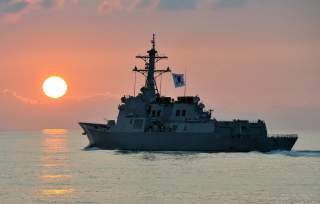The Secret Sauce That Made South Korea a Naval Power
A powerful shipbuilding industry.
South Korea’s shipbuilding industry leads the world in civilian orders.
But it has lagged behind China in the speed at which it is putting out warships. Despite the relative sluggishness of warship production, South Korea has the ambition to be a strong “middle-power” blue water navy.
The fielding of the modern KDX-2 and KDX-3 destroyers is a testament to this.
The new Dokdo-class Landing Platform Helicopter (LPH) helicopter assault ships further bolster the capability for the Republic of Korea Navy (ROKN) to execute power projection. But how do these ships fit into the ROKN’s overall naval strategy? Could they be used as miniature aircraft carriers, similar to Japan’s plans for their Izumo-class helicopter destroyer?
To understand why South Korea is building an LPH, one must look at why South Korea began to expand their blue water navy.
South Korea’s rapid economic growth has been largely based on maritime trade. For South Korean elites, a large blue water navy was considered necessary to protect said trade.
Recommended: A New Report Reveals Why There Won't Be Any 'New' F-22 Raptors
Recommended: How an ‘Old’ F-15 Might Kill Russia’s New Stealth Fighter
Recommended: How China Plans to Win a War Against the U.S. Navy
This was recognized by the country’s admiralty, and in 1995, Admiral An Byoung-Tae asked then-President Kim Young-Sam for permission to begin planning the construction of a modern series of ships. This plan was approved and put into action shortly after. In later writings, Admiral An laid out his vision for an expanded South Korean blue water navy: it should be able to operate as a member of a multinational coalition, operate short-term in theaters as distant as the Strait of Hormuz, and operate long-term in the East Asian region. In doing so, it would allow South Korea to be more influential in international affairs.
Today, South Korea uses it’s 7th Maritime Task Flotilla to accomplish this power projection task, which includes three Sejong the Great-class destroyers and six Chungmugong Yi Sun-sin-class destroyers, and some attached submarines.
The 7th MTF has served effectively in counter-piracy operations off the coast of Somalia. In the future, this flotilla is planned to be expanded into the Strategic Mobile Fleet. Korean military experts have expressed the opinion that ships such as the Dokdo-class LPH should be part of such a fleet. A LPH would improve the ability to conduct all varieties of power projection and naval operations. UAVs launched from the deck could allow for better round-the-clock naval surveillance, and operating helicopters from an LPH is easier than operating helicopters from the rear deck of a destroyer. The LPH also is capable of housing a sizable contingent of marines, allowing for easier participation in peace operations near a foreign coastline.
From a technical perspective, the Dokdo-class is better suited to power projection operations than other small helicopter ships like the Izumo-class. The Izumo-class is largely defensive in nature, due to the overall stance of the JMSDF. Izumo-class ships are largely geared towards anti-submarine warfare (ASW) and patrol, hosting a complement of seven SH-60J or SH-60K ASW helicopters.
The Dokdo-class, on the other hand, is mainly geared for offensive operations, specifically over-the-horizon amphibious landings-- equipped with a well deck and two LCACs so it can conduct these operations, allowing for land numerous marines and even main battle tanks.
The helicopters the Dokdo-class utilizes are the UH-1s and UH-60s. But the ROKN does not field the navalized SH-60 variant, rather relying on variants of the British Lynx design for naval patrol. This may hinder the ability of the Dokdo-class to perform traditional naval helicopter operations with its H-60 fleet, but in an assault role, this should not pose a big issue. The second ship in the Dokdo -class, the Marado is also being built to support multiple V-22 Osprey tiltrotor aircraft, which are being considered for purchase by the ROKA.
The Dokdo-class was designed to support VTOL jets operations from its inception, and South Korea is considering buying F-35Bs for their Dokdo-class ships. However, South Korea’s LPH are not very big. Putting F-35s on the Dokdo class would likely limit its ability to host marines and helicopters.
The US Navy’s Wasp and America-class amphibious assault ships are almost double the tonnage of the Dokdo-class, as they are expected to field VTOL jets in addition to a full complement of marines and helicopters. Accordingly, any use of the Dokdo-class as an VTOL aircraft carrier would likely have very small numbers of aircraft fielded, and would represent a significant tradeoff in the other capabilities of the class. But doubtless is that the Dokdo-class represents a significant upgrade in the ROKN’s blue water fleet and another step forward to fulfilling Admiral An’s vision.
Charlie Gao studied Political and Computer Science at Grinnell College and is a frequent commentator on defense and national security issues.
Image: Wikimedia Commons

